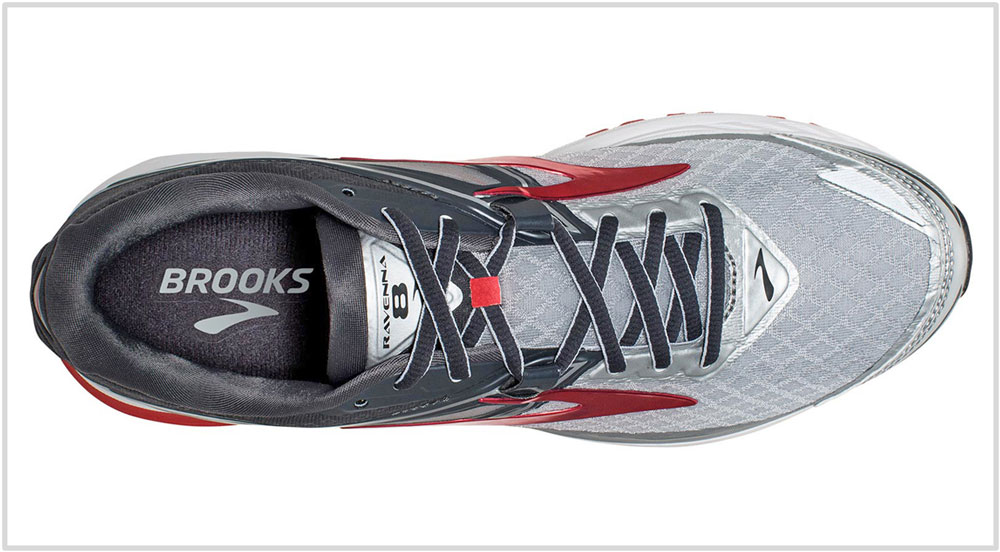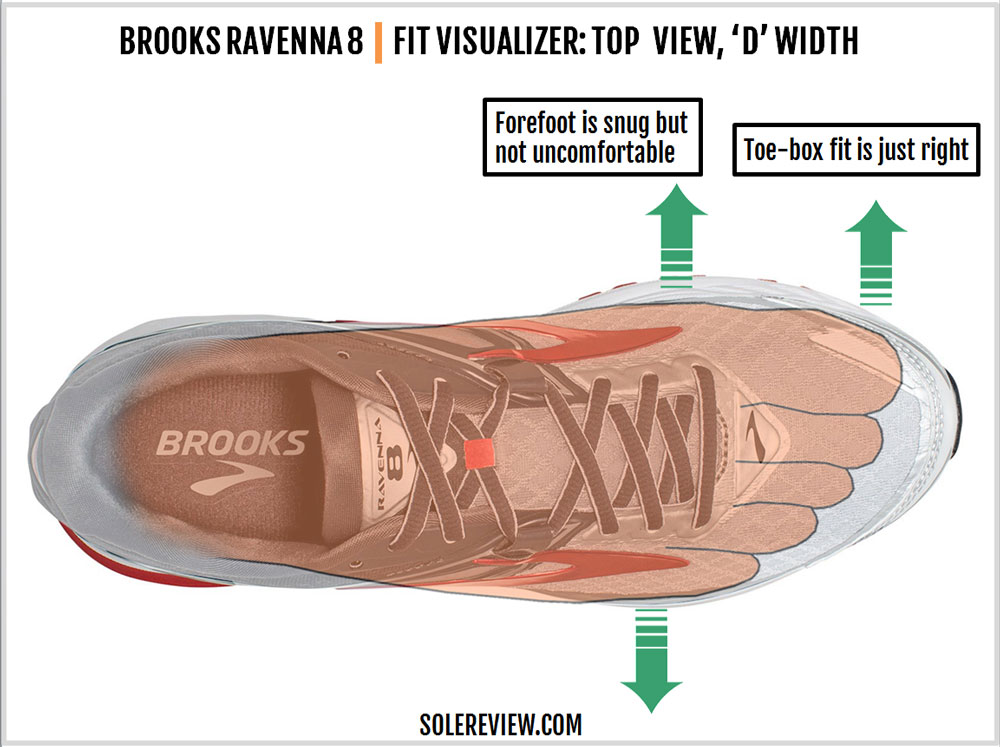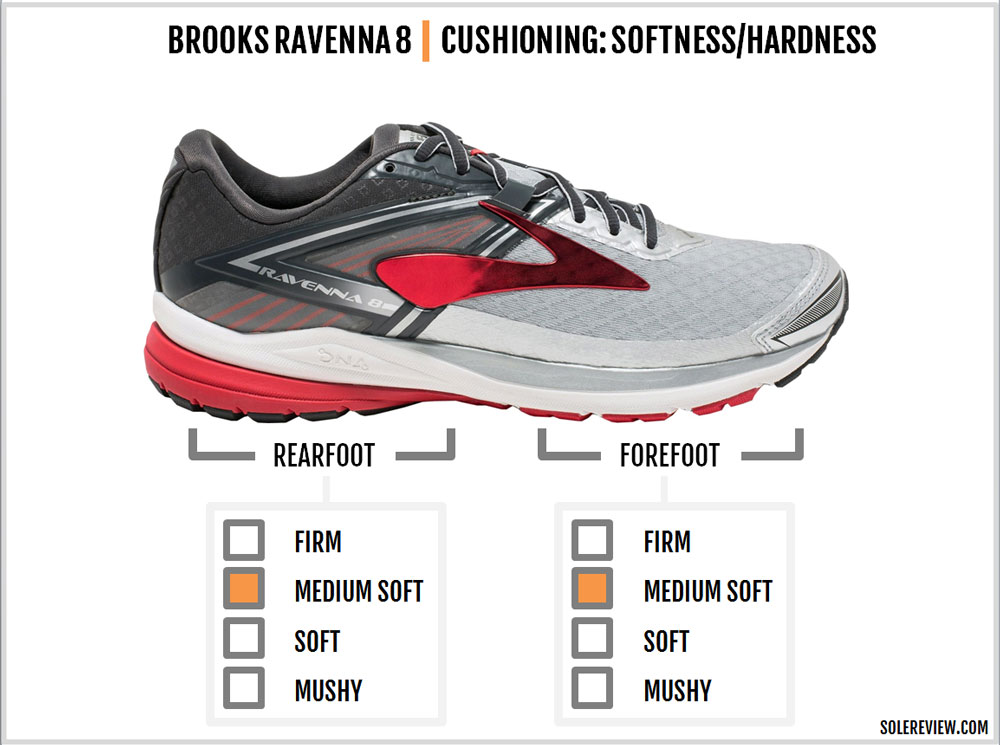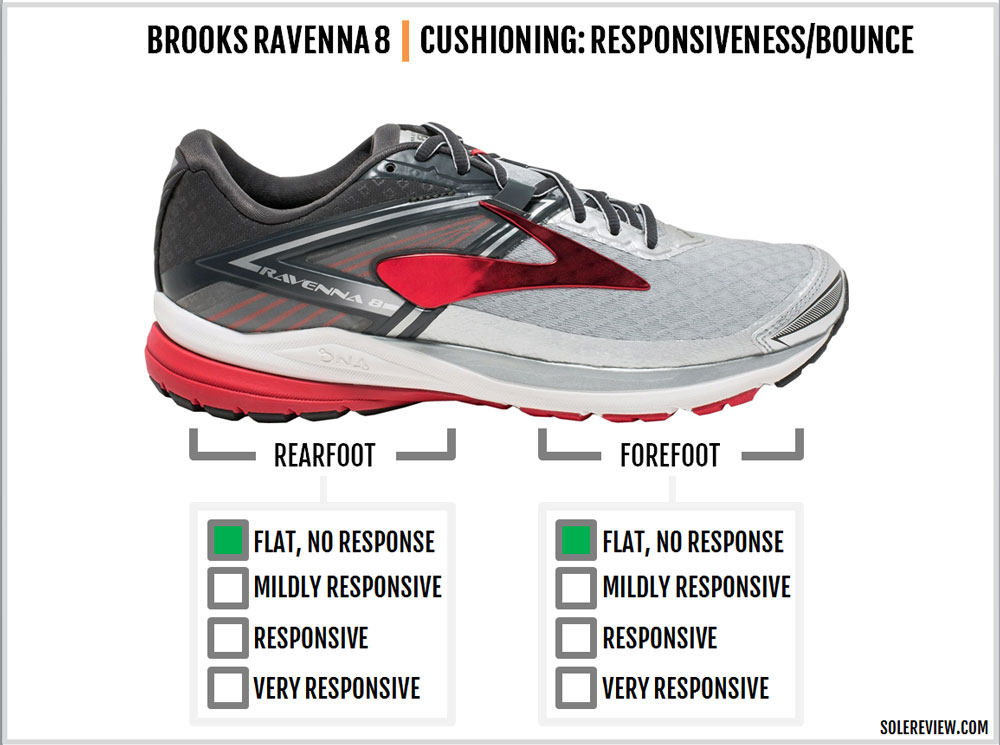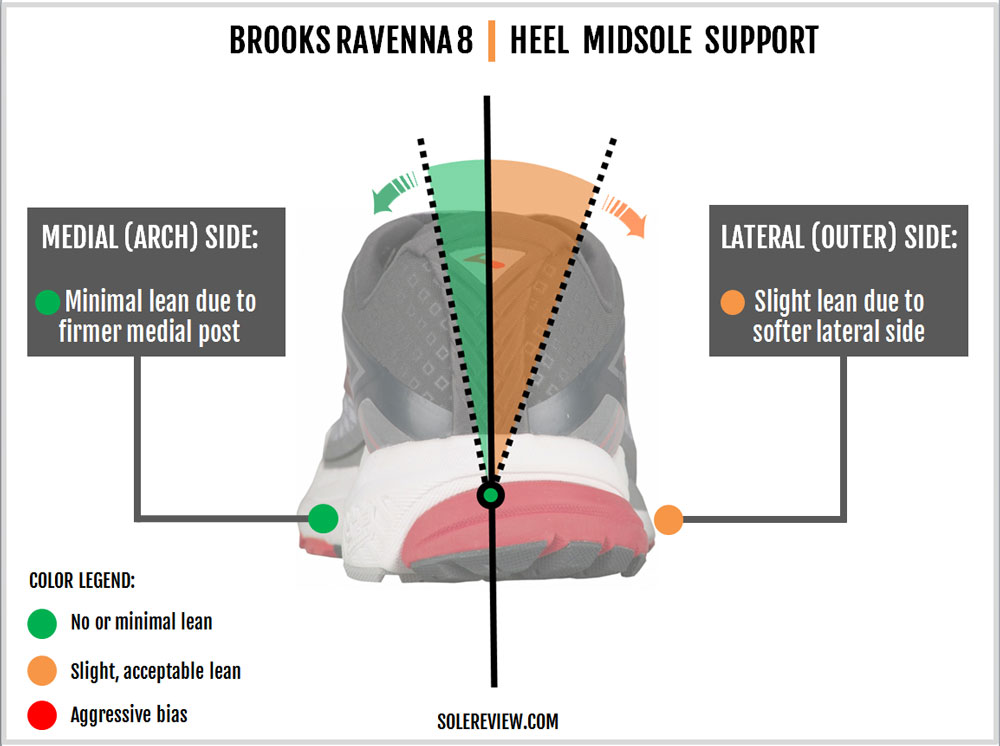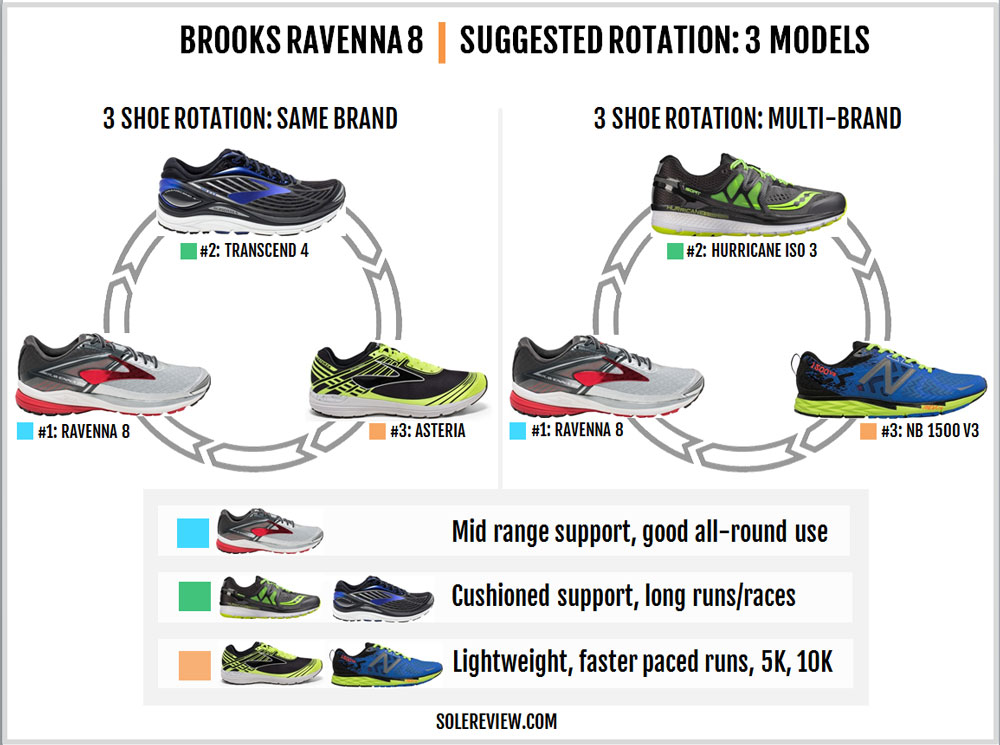INTRODUCTION
Until last year, the Ravenna had an MSRP of $120, priced the same as the Adrenaline GTS and similar to other shoes (Nike Structure, Saucony Guide, etc.) in the cushioned support category. The 2017 Ravenna 8 drops its price to $110, placing it a rung below the Adrenaline and giving it a significant value advantage over mild-support models in the $100-115 price band.
While the basic premise of the Ravenna 8 stays the same – it offers mild medial side support integrated with a well-padded midsole – the design language is now closer to the Launch 4. The upper profile of both these models are very similar, and even the Launch 4’s outsole layout is a dead ringer for the Ravenna’s design.
It’s almost as if the Ravenna is now a support version of the neutral Launch 4 instead of a toned-down Adrenaline. By the way, all these design changes are intentional, and perhaps one of the reasons behind the Ravenna 8’s price drop. After all, an $110 MSRP brings it closer to the Brooks Launch’s pricing territory.
The Ravenna 8’s newfound love for the Launch-ish design means that there are changes over the Ravenna 7. The upper loses a lot of layering, and the ride turns slightly firmer.
DESIGN AND MATERIALS
The Ravenna 8 has a clean forefoot design. There’s a stitched-on synthetic toe cap along with a fused layer which extends sideways on the mesh upper. The rest of the toe-box/forefoot is all mesh, with three lacing rows floating over it.
On the midfoot sides are welded Brooks logos which provide cosmetic detailing as well as structure; the lacing area is reinforced with thin, fused layers.
This design is a significant change from the Ravenna 7’s forefoot which was crowded with fused layers. The R7’s toe-bumper was much higher (on the sides) than the 8; that said, the Ravenna 8’s lower toe-bumper is longer on the sides.
It is worth noting that both the Ravenna 6 and 7 had fused toe-bumpers; the Ravenna 8 has a stitched kind. Also, the R8’s toe-bumper gets a reflective trim, something which the 7 did not have.
Two midfoot straps form a part of the lacing. This isn’t new for the Ravenna – the V6 and V7 had these straps too. They’re meant to provide greater lacing cinch around the midfoot area. The soft, round laces pass through these wide loops, so tugging on them results in increased midfoot wrap.
Most of the upper detailing and structure is concentrated in the rearfoot. The synthetic midfoot strap (which connects to the lacing) flares out wide and connects to the midsole, and it’s layered over with a see-through mesh.
The lining used for the heel and tongue is soft, identical to the material used on the Launch 4. The tongue is packed generously with foam, and the heel lining has plenty of it too.
Outside the heel, the Ravenna 8 sticks to an uncluttered layout, using only a vertical piece of molded mesh with reflective detailing. All Ravenna versions so far have used an internal heel counter, and the V8 is no different.
There’s one update which influences the R8’s heel fit. The Achilles dip area has been put together differently than the Ravenna 7; the Ravenna 8’s Achilles dip does not curve inwards as much as the 7 did. While there’s no slippage, the heel grip feels lower when compared to the 7.
For reasons unknown, Brooks has removed the ‘tongue-tied’ loop used on the earlier Ravenna models. In most (other) cases, Brooks uses a second tongue loop to keep the tongue from sliding when there’s no inner sleeve. In the absence of this feature on the R8, expect mild tongue slide.
The Ravenna is marketed as a stability shoe, so the midsole relies on multiple foam densities to deliver the mild motion-control effect. The outer midsole has a softer crash pad (in red) while the inner side has a firmer foam wedge.
One of the design changes we saw in the last year’s Ravenna 7 was the visual integration of the firmer medial wedge into the midsole. Till the Ravenna 6, the firmer medial post was noticed as a distinct visual element. Now it’s hard to tell the density difference unless you poke the midsole with your finger or go for a run.
Although, when compared to other stability shoes in the Brooks assortment (Adrenaline, Beast et al.), the Ravenna’s medial post is quite small and does not produce the same effect. The Ravenna 8 also has a ride which feels softer than the Adrenaline.
On a related note, the R8 has a slightly firmer ride than the 7. This happens due to a couple of factors. The crash pad tones down the deep compression groove which the R6 and 7 had, so the outer midsole becomes a bit firm.
There are a few changes on the outsole too. The forefoot gets an increased coverage of softer blown rubber which fills up most of the gaps seen on the R7. The last generation Ravenna had a longitudinal groove; the R8 fills that over and sticks to sideways oriented flex grooves only. The lug design is smaller too, which translates into improved grip and smoother transitions over the R7.
Certain design elements like the plastic half-shank on the midfoot are carried over from the previous year. This plastic component is only limited to the medial (inner) side; the outer side is an extension of the rubber outsole.
The rearfoot outsole layout looks familiar because you might have seen it on the Launch 4. The landing area is made out of two pieces of rubber separated by an area of exposed foam; the grooves on the rubber crash pad are longer than the Ravenna 7, but is fewer in count. The R7’s outer crash pad had eight flex grooves, while Ravenna 8 only has six.
So in case you’re wondering whether the longer flex grooves makes the ride softer on the R8, the answer is no. Any change in the flex groove design is offset by the latter’s reduced count.
The insole is a removable type which is molded out of soft Biomogo foam, and there’s another layer of foam lasting underneath. The textile used on the insole has a soft hand-feel with a nappy texture.
With its robust build quality, the Brooks Ravenna 8 should have a median lifespan of 350 miles. Brooks has always used quality materials no matter what the price, so their shoes rarely fail prematurely.
That said, expect standard wear and tear patterns. The EVA-based midsole foam’s cushioning properties will degrade over time, and the Brooks rubber grippy rubber outsole compound tends to wear faster than the material used by other brands like adidas, Nike and Saucony.
UPPER FIT AND FEEL
Switching to a stitched toe-bumper ensures adequate toe-box height. You won’t experience the toe rub of the Ravenna 6, and there’s slightly more room than the R7 too.
The midfoot fit is standard Ravenna. The dual straps used in conjunction with the lacing provide localized cinch, and the soft tongue has enough padding to filter the top-down lacing pressure. Expect a small amount of tongue slide. As mentioned in our upper breakout, the tongue isn’t sleeved and omits the ‘tongue-tied’ loop.
The heel lining is very comfortable, the result of a soft lining and generous foam fill. However, the redesigned Achilles area reduces the angle of the inwards curve. So the heel doesn’t feel as secure as the Ravenna 7 did.
Not only does the stitched toe-bumper increase vertical room, but its shorter height (compared to the 7) opens up room on the sides too.
The same applies to the forefoot as well. The R8’s upper barely has any layering, so the interior fit feels smooth and consistent. Though the Ravenna 8 has a snug forefoot, the fit quality is comfortable. The shoe fits true to size.
RIDE QUALITY AND BEHAVIOR
The Ravenna ride falls in the medium range of softness. Just above the foot, the molded insole and foam lasting provide the first layer of cushioning. The rearfoot midsole has a separate crash pad, so that adds to the cushioning level.
Do keep in mind that the Ravenna 8’s crash pad does not have the deep groove running down its sides like on the R6 and 7. This makes the outer midsole a bit firmer than the previous Ravenna editions.
The outsole helps with soft landings, thanks to the separate crash pad and the area of exposed foam below the heel. There’s plenty of blown rubber in the front, so the landings aren’t jarring for forefoot strikers. All in all, the softness is well distributed throughout the midsole.
As such, the Ravenna 8 makes a good case for itself as a daily trainer, no matter what the mileage. There’s enough foam between your foam and the ground to make long-distance runs comfortable.
Like most Brooks shoes, the Ravenna 8’s midsole lacks a spring-back sensation.
The DNA material feels close to ordinary EVA foam, so you’ll miss the bouncy feel produced by competing midsole tech like the adidas Boost and Everun.
One of the effects of the toned-down grooving on the heel crash pad is better rearfoot stability.
While there is a bit of outwards (and acceptable) bias due to a harder inner midsole, the crash pad doesn’t compress as much as it did on the R6 and R7. So you get a balanced ride experience with the R8, and the firmer medial post is barely noticeable; think of the Ravenna 8 as a near-neutral shoe with a wee bit of medial support.
The midsole softness is quite consistent along the length of the shoe minus any ‘sink spots,’ so the transitions are smooth and efficient in nature. The updated forefoot with increased rubber delivers a planted ride.
PROS AND CONS
With a $10 reduction off its retail price, the Ravenna 8 is excellent value for money, especially when you compare it to similarly priced shoes in the market. No signs of cost-cutting are visible on the shoe.
The upper materials look and feel premium, the midsole packs in multiple densities and a plastic shank, and the outsole could very well be from a higher price segment. You even have additional widths.
It’s not just in the area of cosmetic detail where the Ravenna proves its mettle. The premium material package translates into a smooth interior fit, and the optimal blend of different foam densities produces a cushioned and efficient ride quality. The R8 might be a ‘stability’ shoe, but the firmer medial post has a non-invasive character.
There are a few areas where the Ravenna could be better at. Of late, the midsole foam tech has evolved by leaps and bounds; any runner who has run in shoes featuring adidas Boost or Saucony Everun know how superior those materials are. Brooks’s DNA foam material feels like regular EVA foam. The Ravenna suffers from the lack of engaging ride experience, as do other Brooks shoes.
A couple of minor gripes would be the less-than-perfect heel grip and the mild tongue slide.
SUMMARY
The Ravenna 7 and 8 are matched on weight, but the $10 price drop is worth calling out. The new Ravenna moves down in price band (from $120 to $110) without any material or feature trade-off (which is great).
As pointed out at the start of this review, the Ravenna moves closer to the Launch 4 in design language and category. This translates into a much sleeker upper design which uses far less layering over its upper compared to the Ravenna 7. This external update also impacts the fit quality, opening up more forefoot and toe-box room than the past two Ravenna versions.
Among other news, the heel grip feels slightly less secure due to the redesigned Achilles area. The tongue leaves the secondary loop behind, so the tongue lockdown isn’t as foolproof as before.
Ride quality is similar to the earlier Ravennas except for a few updates. The rearfoot is marginally firmer due to the reworked crash pad, and the forefoot gets a better spread of cushioning thanks to the better blown-rubber coverage.
Till last year, the Brooks Ravenna and Adrenaline were priced the same. In 2017, there’s a $10 price difference. But that pricing gap shouldn’t be your guide when deciding to choose between the two.
Rather, buy the Adrenaline if you require more support and firmness in the midsole. It has a larger medial post and a firmer ride quality. On the other hand, the Ravenna is softer with a mild-support character. The Adrenaline also comes in more widths than the Ravenna 8 (which only offers a 2E-Wide), so if you’re a 4E (extra wide) or B (narrow), then the Adrenaline GTS 17 it is.
The Brooks Beast 16 makes sense when you need tons of support. The Beast works well for heavier runners, and it has a lot more cushioning than either the GTS 17 or the Ravenna. The upper fits narrow and small so that’s something you should be mindful of.
RECOMMENDED ROTATION
If you love Brooks and want to say within the brand, then the Transcend 4 and Asteria pair well with the Ravenna. The Transcend 4 is a support shoe without a medial post; its exceptionally wide footprint delivers a supportive ride. There’s plenty of padding from the SuperDNA foam midsole, and the upper materials produce a plush fit.
For 5k and 10k races, the Asteria is a sensible pick. It features a mild-support wedge within a lightweight package and is good for shorter races. You can run up to a half-marathon but most will find the cushioning lacking for longer distances. You’re better off running longer distances in either the Transcend or the Ravenna.
The Saucony Hurricane ISO 3 offers more cushioning than the Ravenna, and is a good choice for longer runs/races of an easier nature. The Everun foam insert and topsole provide a certain degree of springback feel, and there’s a generous amount of midsole padding.
The New Balance 1500v3 competes with the Brooks Asteria, so in case you want brand variety, the 1500 performs the role of a fast racer well. It is more versatile than the Asteria because of its higher cushioning level. Most runners should have no problems up to half-marathon distances.
SIMILAR CUSHIONED SUPPORT SHOES
If this was last year, the Ravenna 7’s $120 price made it comparable to models like the Asics GT-2000, Nike Structure 20, or the Saucony Guide 10. But the new (and cheaper) $110 forces us to have a relook at the comparison chart.
And this category revision makes better sense too. After all, the barely noticeable medial post on the Ravenna behaves differently than the larger wedges found in the GT-2000, the Guide 10, and their kind.
With that said, the Ravenna 8 is a closer match with models which are a rung lower, both in price and function. At an MSRP of $100 is the well known Asics GT-1000 5. It is the less expensive version of the GT-2000, and features a basic material spec and a firm ride. The Gel Exalt 3 at $10 lower is nearly the same shoe as the GT, except that the midsole does not have a visible Gel unit.
Only a price difference of $10-20 separates the GT-1000 and Exalt from the Ravenna, but the Brooks shoe uses materials far superior to Asics. The Ravenna 8 also has a more sophisticated ride quality than both the Asics models.
The adidas Vengeful is modeled on the excellent Supernova Sequence, but somehow adidas managed to ruin the Vengeful. So while we mentioned the Vengeful for the sake of comparison, the shoe is better avoided. Read our review to know why.
Nike has a shoe called the Zoom Span which has an extremely mild support wedge. It is much lighter than all the shoes mentioned above, and runs softer too. Worth a try if a lightweight support shoe is what you’re after. The downside is that it feels a bit flimsy when compared to the Ravenna.
Skechers has only recently introduced support shoes in its performance assortment. It started with the Strada which was then followed by the Forza.
The Forza V2 is a Skechers outlier in the sense that it has a 8mm heel drop (most Skechers shoes have a 4 mm drop) and a dual-density midsole. The Forza has a firmer ride than one would expect of a Skechers shoe, and the outsole has plenty of rubber. Not surprisingly, the shoe weighs nearly as much as the Ravenna.
There are a couple of other support shoes in this price range. The New Balance Vazee Prism V2 is a firm, medially posted shoe with a sleek upper profile, and is almost an exact weight match (10.4 oz) with the Ravenna 8.
At a MSRP of $100, the UnderArmour Charged Bandit 2 packs plenty of value. The upper with seamless heel cup draws design inspiration from the 2014 Speedform Apollo, and the dual-density midsole produces a supportive ride without resorting to the use of a medial wedge.




